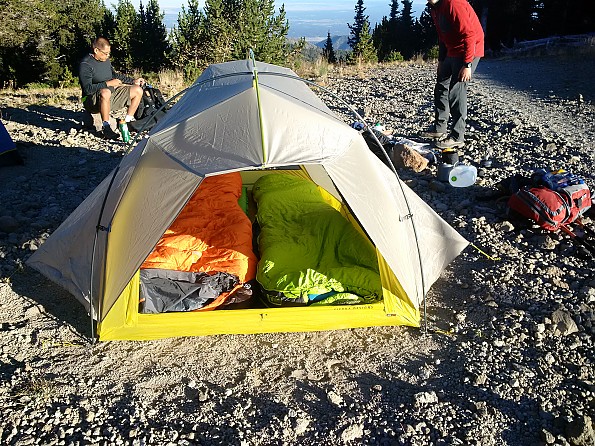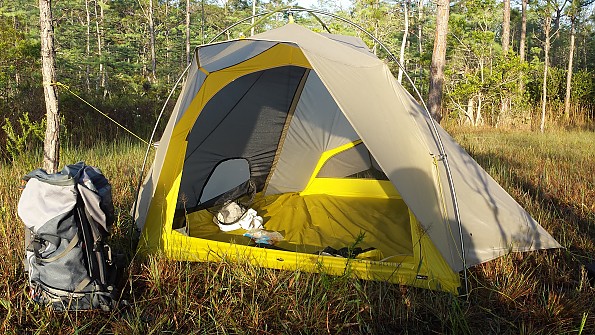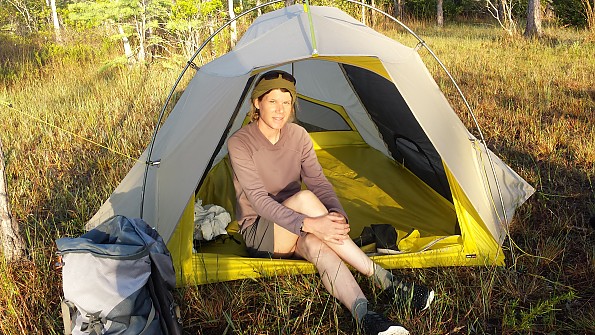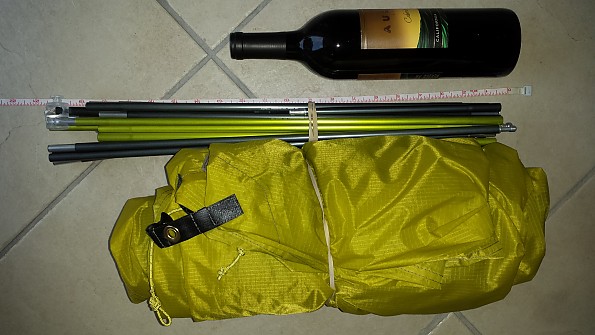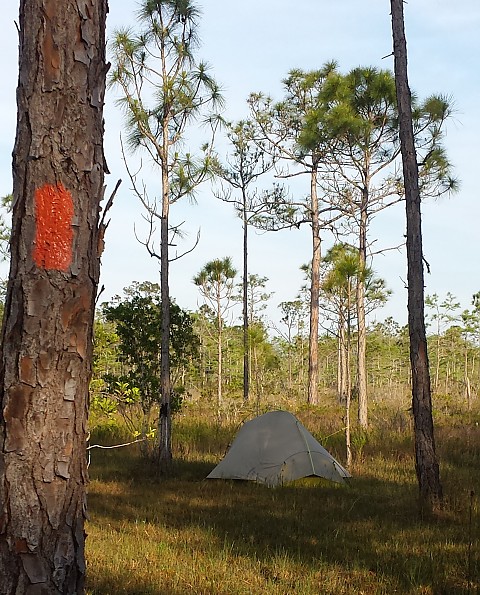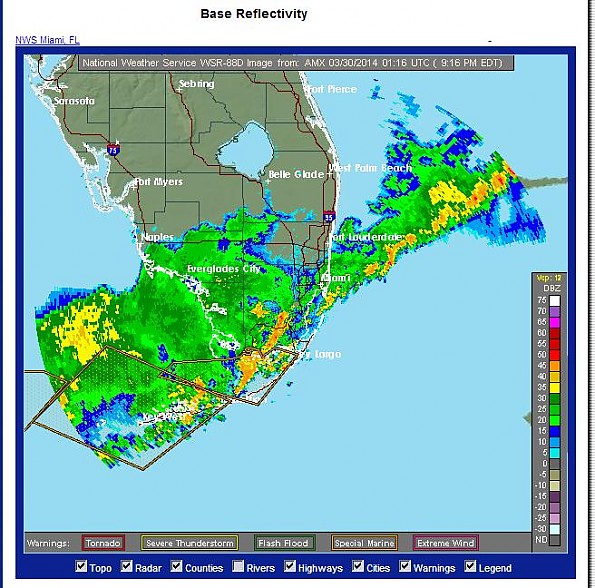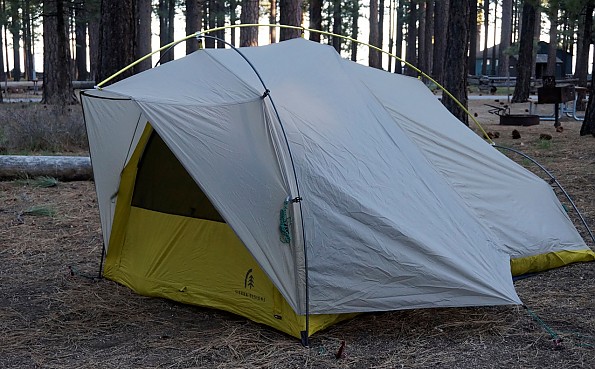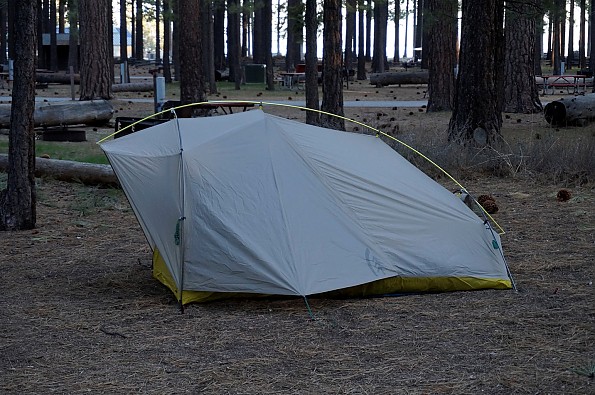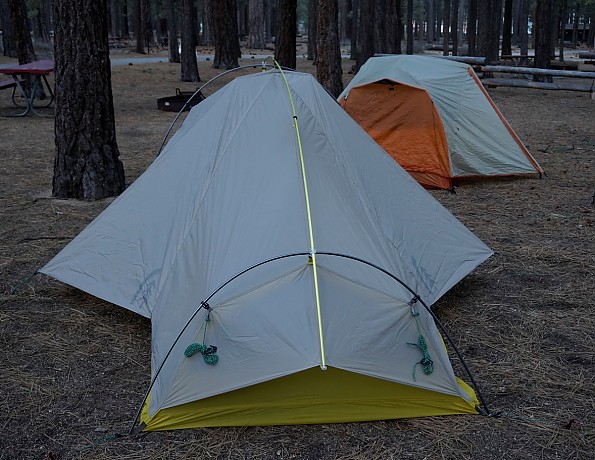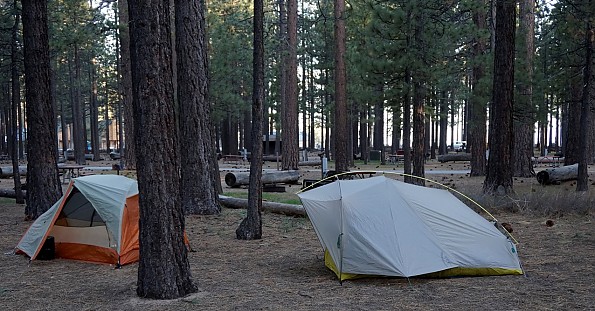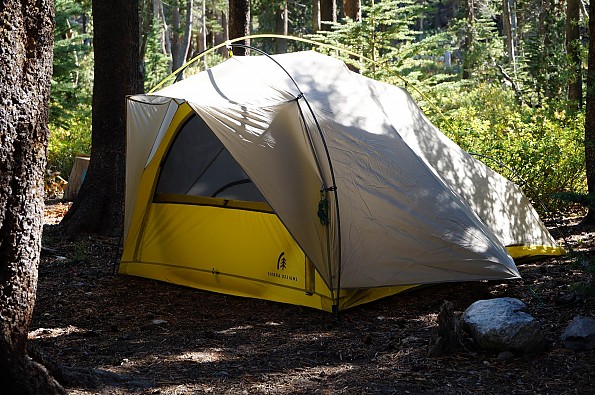Sierra Designs Lightning 2 UL
The Lightning 2 UL has been discontinued. If you're looking for something new, check out the best three-season tents for 2025.

Sierra Designs has a very unique approach to tent and equipment design, and the Flash 2 UL is no different. From the unique structural support to the overall "porch" process, the Flash gives those looking for a fresh new take on tents a way to get out there, in a light, roomy fashion without making huge sacrifices.
I recommend for someone looking for more room as a 1-person sleeping option or for lovers who want to be close on their trip.
Pros
- Unique design, like the porch concept
- Strength, good sturdy tent even in windy conditions
- Good build quality and materials
- Roomy for 1.5 people
- Easy access to gear on the sides
- Fast setup, built in poles connect quickly
- Hybrid single/double layer tent—makes it even lighter
- Pivot poles and side poles give lots of headroom
Cons
- Front entrance is a challenge if sleeping 2, or intially
- Porch is not huge, so although I have not used it in rain, it would limit side penetration
- Gear space is limited on the sides to one pack per side (barely)
- Hybrid single/double layer tent - question the ability to stay dry in high humid conditions
- Integrated poles make stuffing impossible, have to fold and roll it up a specific way
I will put the caveat that I do not have a lot of time in this tent. I do not own the tent, I have only borrowed it and used it with my brother.
Having said that, I would like to share my impressions of the tent, having given a lot of thought to this tent as well as others as I venture out to find the perfect tent for me.
Some of the must have features for a tent for me:
- goal weight of 3 lbs or under.
- Good quality material and build without sacrificing durability and longevity.
- Ability to stay dry and comfortable even if I have to spend hours in the tent.
- Easy setup and take down
Now that I have some time with this tent, I wanted to cover some of how this fits into this category.
The tent has a unique design, which is missing traditional vestibules, but has a porch style overhang, giving you the ability in a drizzle to hang out with the window open and still enjoy fresh air. It was really nice to sit and enjoy and get ready without having to climb all the way through a vestibule.
This does however limit the gear storage. While gear is easily accessed through side zippers, gear storage for two people was a little tight. I will also say while we are speaking of tight quarters, I think this is a tent for lovers, not friends. I shared it with a kind brother willing to put up with my closeness, smell, and tornado sleeping habits.
I highly recommend only sharing this tent with someone you don't mind getting very close, nearly intimate, with.
This is pretty common to other tents I have researched, so I can't say it's a unique limitation to this tent. But given it is larger than 1-person tents, without being much heavier, this is a bonus ability in a pinch to have two non-lovers sleep. For example you and a buddy are out and the weather turns bad and you feel bad that your poor buddy is out there suffocating in his bivvy. Invite him over for a one-night stay kind of experience.
Having set this tent up with limited experience, it was pretty dang easy. It went up fast and after figuring out the pivot and locking connection contraptions, it was the fastest by far to set up in our group of ten people on the trip.
It was also very stable once staked out. Winds around 5-10MPH were all around us and I did not feel that this needed any adjustment at all. Kudos to the elastic on the stake points to assist with this process.
The hybrid double/single wall design gives you an area around your head of double wall protection, while giving single wall at the feet. Great design and it worked, I had no moisture problems at my breathing end, only at my feet, which always tends to happy as if I only sweat at my feet.
Given this, I would have a little bit of concern in really humid conditions that the tents foot bed would cause someone like me to have excessive moisture and wake up wet and cold if two people where causing the sleep bag to touch the walls there.
My brother and I split up the weight of the tent, and like many tents, it was designed from the get-go for this process, the packing was split very evenly with weight and bulk pretty well distributed into two.
Great quality stakes were provided and the poles felt strong and of good materials, so no problems there. The tent was pitched right on top of a nearly level spot on volcanic type rock/gravel that we cleared of major sized pieces. I was really concerned that we forgot the footprint and we were going to damage the tent. This did not happen and it staked out quite well given the conditions.
Taking it down was just as easy, but packing it was a bit of a challenge. The mini side poles built into the top of the tent that give great headroom cause problems with being able to stuff the tent.
I am of the opinion that tents should be stuffed as to not cause the waterproofing to fail, but with this tent there is a pretty specific pattern you have to put things back into the bag.
While this is a minor inconvenience, I would not say that it is a deal breaker for the tent, just get over it and fold the darn thing back up. At least the poles give you a size to aim for and aide you that way so you can get it back into the sack.
Source: borrowed it
The new Lightning 2 UL is an efficient, roomy, lightweight 2-person backpacking tent incorporating some new features that set it apart from other tents. With a one-piece hybrid-walled body and single hubbed pole frame, setup is fast and easy and the weight kept minimal.
A freestanding structure adds versatility while the single front door with awning provides an open and more welcoming interface. Moving the vestibules—gear closets—to the sides with panel access from within keeps stuff out of the entryway but still accessible. All materials and accessories are provided with quality and durability in mind.
Note that this tent is offered at two price points, with the non-UL model being $100 more affordable but weighing slightly (7 oz) more. Decisions, decisions.
Pros
- Lightweight for a 2-person shelter, or even for a 1P
- Freestanding
- Very easy to pitch
- Includes quality poles, stakes, and guy lines
- Innovative new features
- Excellent open living space
Cons
- Footprint extra (this is pretty standard)
- Single-walled section can put you in contact with condensation
- guylines don't have reflective tape

Here are the summary tech specs from the manufacturer:
Best uses: backpacking, ultralight, Capacity: Two people.
Minimum weight: 3 lb. 7 oz. / 1.55 kilograms, Packed Weight: 3 lbs 14 oz.
Tent area: 29.9 sq. ft., Tent floor dimensions: 7'2" x 4'8" or 86” x 56” (foot width: 44”)
Vestibule/Gear closets area: 4.1 + 4.1 sq. feet each
Awning Height/Overhang: 36” / 15” Peak height: 3' 6.5" or 42.5” Doors: One.
Poles: One DAC NSL shock-corded aluminum pole. Jakesfoot and clip attachments
Stake Type Quantity: 10 DAC J Stakes
Fly Fabric: 30D Nylon Ripstop 298T, Silicone/PU 1500 mm, FR
Floor Fabric: 40D Nylon Ripstop 238T, PU 3000 mm, FR
Body Fabric: 20D Nylon No-See-Um Ultralight Mesh
Here are a few of my own, independent findings:
Tent body weight (guy lines removed): 40 oz.
Pole weight: 15 oz.
Total minimum weight (no stakes or guy lines): 55 oz. or 3 lbs. 7 oz. (as advertised)
Stake weight: 4 oz. for all 10 stakes
Pole length: minimum 20 inches
The tent body can be rolled around two 15” awning poles or these can be removed from their sleeves so that the body can be stuffed.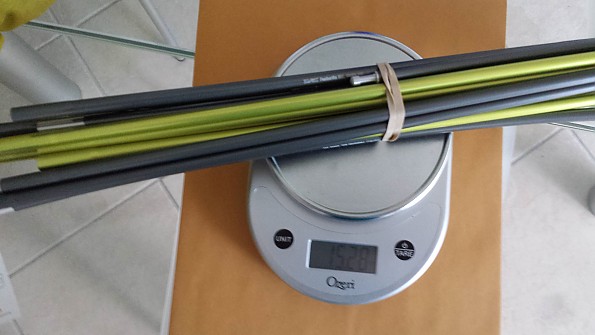
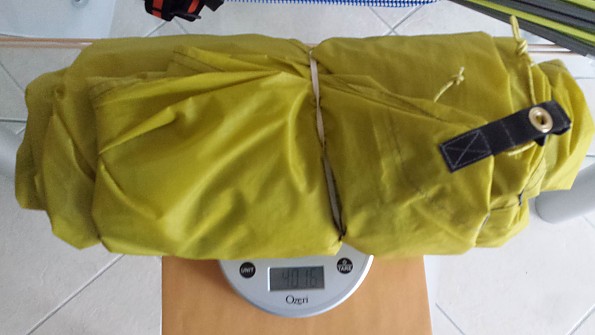
Setup
The Lightning passed my ‘out-of-the-box-sin-instructions-pitch’ test with flying colors. Being that it is billed as an easy pitch design, I wasn’t really surprised that it took no time to figure out on my own. But I’ll admit that owning and thus being familiar with other Sierra Designs tents made the process a bit easier.
This company has made great strides in incorporating a few simple but ingenious pieces of hardware, namely hubbed swivel poles, jakes feet, and poles clips. Having used such features now for over 6 years with my Sirius 2 and later the LT Strike, I can confidently say that they really do speed things up.
The Lightning tent also offers a hybrid single/double wall design in which the fly and tent body are integrated. So there is no stumbling around in the dark trying to orient a separate fly correctly or deciphering which side should face up. Of course the downside of this is that you can’t shed the fly in fair weather to save weight or use it as a stand-alone emergency poncho and/or pack cover….rather insignificant beefs, though.
Another interesting point is how the poles serve as an exposed exoskeleton versus the traditional tent-pole-fly sandwich that most tents abide by. I couldn’t really find any detractors in this new design and as an unintended bonus, there is ample opportunity to hang or clip small items to the outside of the tent…a built in sock-drying rack.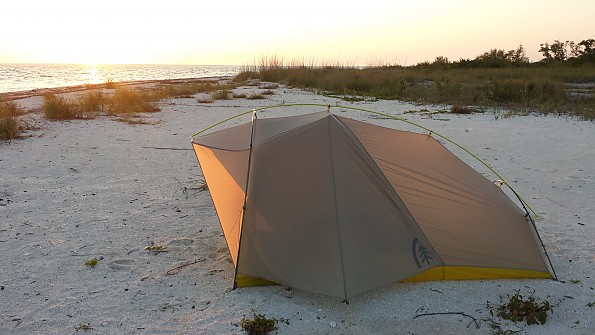
But back to the setup and how the incorporated hardware make it so easy.
First, gone are the days of having to thread a pole through a pole sleeve…an infuriating process in the rain and cold. Clips are a no-brainer, add negligible weight, and I’ve yet to have one fail.
Secondly, Sierra Designs hit the target with their signature single hubbed pole designs. In this way, you don’t have to spend time figuring out the orientation of separate poles…the swivel points connect and orient the poles automatically. I’ve appreciated this very much with my Sirius 2, which is a simple dome with two cross poles and one swivel hub connecting them in the middle.
In contrast, the new Lightning 2P reverts back to a classic hoop design but with a ridgeline center pole connecting the two cross hoop poles…which is how it also achieves it free-standing credentials. If you follow SD’s advice in staking out the four corners of the tent first, it becomes pretty obvious how to lay the poles.
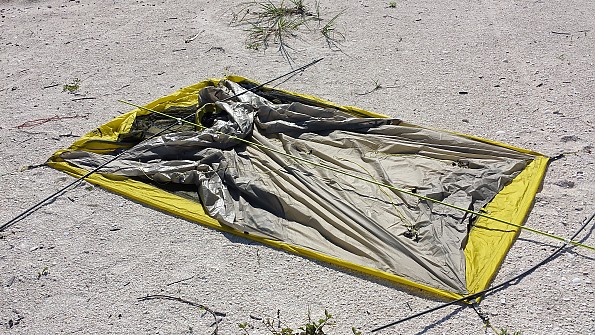
The only part I initially got wrong was laying one of the cross poles with the H-Clip facing up. A quick rotation of the pole at the swivel clip fixes this. Next, the ends of the cross poles are inserted into the four corner grommets. At this point, the frame takes shape and it’s just a matter of clipping the body of the tent to the frame, a task even a city-slicker can be assigned. Insert both ends of the ridgeline pole into the jakes feet (now called ball cap connectors) to form the awnings and it’s just a matter of tinkering from there.
Stability
Sierra Designs generously includes 10 (count ‘em 10!) quality DAC J 6” aluminum stakes in the package, which covers all points: the 4 corners, 4 guy lines, and 2 gear closets.
I would argue that a pretty taut pitch is initially and easily achieved without staking, due to the freestanding pole structure. This is true with the exception of the gear closets. These two points do need to be staked out, otherwise will not achieve their purpose in creating vestibule space and probably not shed water or ventilate the tent as well.
The interior space is also reduced if these wings are not staked. If camping on a surface where stakes are a no-go, possible improvisations for the gear closets include rock anchors and guy lines. LineLoc pull tabs on the 4 corner points and two gear closet wings allow for further tensioning of the tent…a really nice, quick and easy feature if at first you didn’t manage to get the stakes evenly spaced.
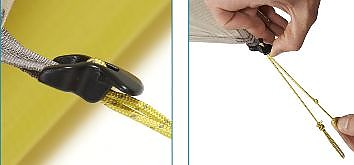
Like with any tent, there are the notoriously time-consuming guy lines to fiddle with to your heart’s content. At least the Lightning has only four attachment points and also provides the four individual guy lines complete with LineLoc cleat devices for quick tensioning. These are similar to the old plastic three-hole do-hickys we’ve all been baffled by, but much better.
Since SD didn’t provide any instruction on how to use these, I’ve included a little visual here. I think they’re pretty simple and useful, while not adding much weight…or the boy scouts amongst us can just resort to reliable knots.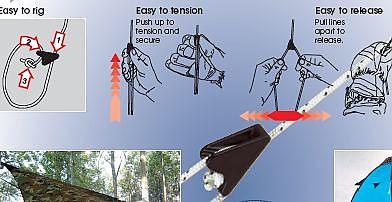
Unlike most tents, the guy lines don’t make a lot of difference in improving the tautness of the tent. But they definitely help anchor it in high winds (and of course Sierra Designs warns that they should always be used to ensure tent stability, ‘cause you never know…). This is probably good advice, since the Lightning does have rather steep sides and sharper angles compared to a dome tent.
In a cross wind on the beach, it became apparent that my short MSR stakes were not going to be enough. And of course, I had forgotten to bring enough stakes for the guy lines, so I improvised by wrapping them around sticks buried into the sand…sand anchors!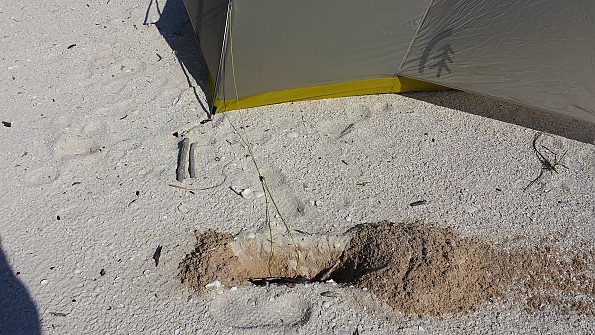
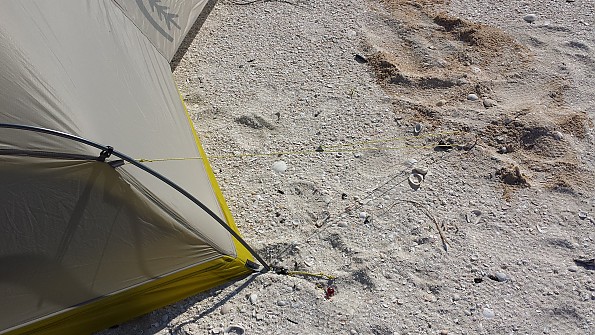
The guy lines served their purpose, because as soon as I removed them the next morning, the tent ripped out the remaining stakes and took off down the beach. Yes, the frame does hold up to a roll or two as well as the usual morning shake out…another trait of freestanding tents that is useful.
Weather Resistance and Ventilation
I found that the Lightning did manage precipitation resistance and ventilation well, with a few concessions. In a rain storm that lasted several hours, the tent shed water just as expected, with not one drop making it inside.
I also noted that when pitched on very damp ground, the floor kept the moisture at bay, even in the absence of a ground tarp (note the water droplets are all on the outside of the floor).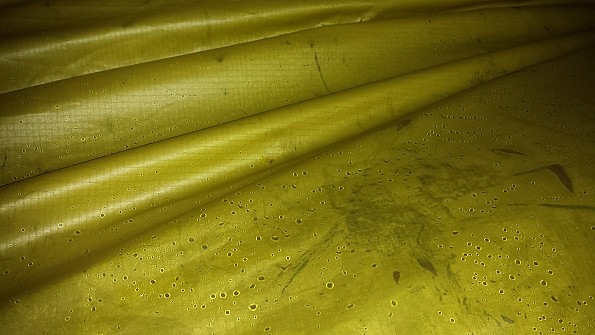
But recall that this is a hybrid-walled tent and thus the single-walled section (essentially the foot box) did manage to catch and trap some condensation…actually quite a bit during one particular night. Consider, though, that the conditions I tested it in are the perfect recipe for condensation.
The pictures I included here were taken after a night spent in a cypress forest, with miles of the surrounding area being flush with moisture. As happens pretty much every night in South Florida, when the temps fall, the high humidity in the air precipitates out onto any surface that can collect it. There was also no wind that night, not that it would have mattered much, as humid as the air was.
I’ve experienced many a night such as this in areas of Big Cypress and the Everglades and I’ve also seen all kinds of different shelters suffer the same fate. So no matter what the claims are in condensation management, the ‘Swamp’ will tend to prove otherwise.
(some condensation dripping down the single-wall near the footbox)
To the Lightning’s credit, it is designed so that the double-walled area surrounds your head and torso. Thus I was spared the annoyance of dripping water on my head. This area also constitutes the majority of the ‘living room’ space in the tent. So when you’re rustling around inside to change clothing or play poker, you’ll mostly be brushing up against the mesh part.
The positioning of the door and foot box mesh is also said to achieve a wind-tunnel effect…but this assumes that there is wind and that the tent has been oriented in the proper direction. At my beach camp, I definitely had all this going for me… until the wind shifted directions in the morning. Nonetheless, I was still happy to find that on this occasion, the condensation remained outside.
At all times using the tent, I felt very much at ease in breathing in the fresh air. If you leave the storm flap of the door all the way down, ventilation is certainly better than can be achieved with most dome designs. With the storm flap all the way up, the tent still provides plenty of ventilation through the sides.
Room & Storage
This Lightning’s most notable new features are the gear closets and the awning. First the closets: the basic premise of these is to separate vestibule space for your ‘outside’ stuff (pack, muddy shoes, smelly socks, etc.) from the entry/exit way of the tent, thus eliminating the conundrum of tripping over said stuff when making a midnight bathroom dash. From inside the tent, you can access these ‘outside’ spaces via small zip windows.
I did find this feature to be useful. With two people in the tent, it’s definitely nice to have the outside space just next to you and also not have to climb over gear. I also liked that I could leave my Platypus water bag outside and snake the drinking tube in through the window for needed sips, thus reducing the chance of flooding the tent with a spilled bag.
The awning: similar to the purpose of a vestibule, the idea here is to provide a small but open space in which to duck out of the rain as you enter/exit the tent. Moreover, it provides a sufficient refuse to be able to enjoy other pursuits…such as cooking a meal without the threat of suffocating oneself or burning a hole in the tent floor.
In a drizzle or even steady downpour, I did find this feature to be preferable to a classic vestibule. It definitely makes the tent more welcoming and livable. Sierra Design’s promotional pictures show two people sitting at the tent opening, side by side, enjoying the awning. I would agree that this is possible, but they both need to be on the small side.
(photo courtesy of JohnBobCarlos)
It probably goes without saying for those that have spent a good amount of time outdoors, rain is a very broad term for a phenomena that takes on a myriad of characteristics. Such knowing outdoors people will note that in a driving, sideways rain (as we are oft to get in South Florida) the awning does not perform as well. In such a scenario, you’re likely going to be forced to batten down the hatches (in this case zip up the waterproof door cover) and wait it out inside the tent.
Unfortunately this was my eventuality one rainy night, though not due to sideways rain, but rather because of a driving swarm of mosquitoes. I do look forward to the day that I can enjoy a fresh rocky mountain shower whilst simultaneously making tea, contemplating the scenery of a meadow, and sitting comfortable in the doorway of the tent, free of biting insects. One can dream.
Packability
As you can see from the pictures, the tent and poles fold to a pretty small size…enough so that I was able to fit all components inside a 30 L pack, along with other necessities for a 30-mile 2-day fast-packing trek. Minimum pole length measures about 20” long…I wish they folded down to about 15” but at least this length will fit inside a carry-on bag, which will be key if the TSA ever comes to their senses and declassifies tent poles as weapons.
I prefer to stuff a tent right inside a pack, much as you would do with a sleeping bag. However, the two integrated 15’’ awning poles must be removed from their sleeves in order to do this. I usually ended up just rolling the tent around them. The tent comes with the usual stuff sack and pole/stake sleeve but I pretty much never use such accessories in order to shave weight and space. Camps socks double nicely as poles sleeves, by the way.
Ease of Use
First, I would say that the Lightning requires an average amount of space for a good pitch of a tent this class. I’ve seen other 2P’s that are a bit more compact but the Lightning is reasonably good in a tight space. I certainly managed to wedge it into a small site at Frog Hammock…so small I later discovered a cypress knee poking into the floor.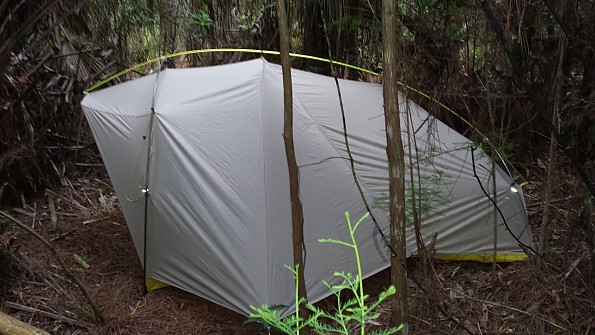
Aside from the easy setup, the layout is also pretty good for two person use…but it has taken some ‘getting-used-to’. I say this because I have become accustomed to having two side entrance doors, one for each occupant, in my other 2P tents. Going back to a single front door is simply not as convenient. Also, most users of single door dome tents have the option of crawling into the tent like it’s a cave, with the door ending up being at their feet.
I suppose you could orient two people like this in the Lightning but it really is designed for the head room to be at the entrance. For one, it’s narrower at the other end and two, the mesh and side pockets are all situated at the entrance. So you end up sitting down inside the entrance to take off your shoes, doing an acrobatic spin on your butt with your legs held high enough so as not to kick your partner in the head, and then sliding the rest of the way in. Exiting is a little easier since you can essentially just crawl out face first.
The tent door also needs to be unzipped at least 3/4ths of the way. It does have double zippers that can be positioned in the center for easier access by both persons, not that this matters much since you still have to reach across to unzip the opposite side a ways. The zipper does work well with one hand, as I didn’t notice any snag points.
For one person, this tent is like having a kingdom unto yourself (and for the minimal cost in weight, it’s very nearly worth it). The peak height is more than enough, so I was thrilled to be able to sit inside the tent, ON top my Alite Monarch Chair, and read for several hours during a rain storm. A single person also has the option of positioning their head at the opposite end, if for no other reason than to enjoy the view the front door offers.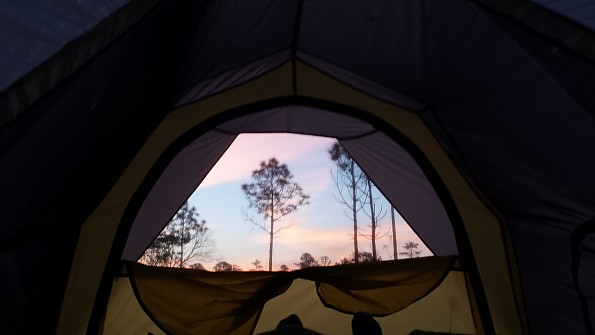
(a room with a view)
A final word of caution: while the awning structure is a nice, useful feature, you should be extra cognizant of the end of the ridgeline pole, especially in tight spaces. On more than one occasion, while quickly bending down to duck under the awning, I became aware that this pole end, even though encased in the ball-cap connector, could do a number on your eye. As is good advice not often followed, drinking and tenting should be avoided.
Construction & Durability
I would expect a tent of this price point to hold up to my uses in just two months (which it did), so durability is a rather untested call. I did use it exclusively without a ground tarp with no apparent problems, so that’s something.
As for construction, the stitching and seams are all solid, the ultralight materials are as expected, the zippers work well, and the poles, cordage, and stakes are all of performance quality.Actually, out of the box, I did find one of the gear closet panel zippers to be slightly separated. I carefully zipped it back together and have had no further issue in using it. This is most likely an uncommon happenstance from shipping. The silicone-treated nylon also produced quite a smell initially, which has thankfully dissipated.
I put this comment here since I don’t really know where it fits, but I really appreciated the colors of this tent. The beige and yellow tones blend in well with natural surroundings, giving it an incognito presence. These colors also liven up the interior, making even a gloomy day seem bright and cheery.
(an orange blaze, marking part of the Ocean-to-Lake trail of the Florida Trail network, maintained and supported by the Florida Trail Association. Don't worry, this is an official campsite and I manipulated the angle to show the blaze and tent...I'm not actually camped on top the trail:)
A Fair Comparison
Since I’ve made mention of dome tent design a lot, I thought I’d offer more of an apple-to-apple comparison of a tent I think represents yet another fresh approach in this weight class, the MSR Fast Stash. A friend has been using this tent, so I have some familiarity with it.
Both these tents have many similarities in that they are marketed as ultralight two-person shelters, incorporate awnings, side vestibules, and one large door. At its reported minimum weight (with trekking poles substituted for the support poles), the FastStash is 9 oz. less than the Lightning’s minimum weight. Yet its packed weight is actually 3 oz. more than the Lightning’s packed weight.
For me, the FastStash’s savings in weight do not justify the move to a non-freestanding tent. Further, the layout of the FastStash places the second sleeper on the opposite side of the single door as opposed to both sleepers having equal access to the Lightning’s door. Imagine having to crawl over your tentmate each time you wish to get in and out…no thank you.
Lastly, the main interior sections of the FastStash are single-walled, whereas the Lightning performs more as a double-walled tent in key places. I greatly appreciate the effort by each company to consistently come up with new, innovative designs but in this instance, I feel the Lightning has the edge.
Conditions
I used the tent from March through April on several backpacking trips around South Florida and for a beach/boating/camping expedition in the Everglades. One of the backpacking trips consisted of a 30-mile haul in two days, where I definitely appreciated the light weight. Our foray to Frog Hammock brought a good evening dousing, so that I could experience hanging out in the tent for several hours to escape the rain. Beach camping better tested its ventilation capabilities as well as resistance to the wind, about 15 kts.
(radar image from the night at Frog Hammock, a typical front moving through, bringing a fresh batch of rain to Big Cypress and the Everglades)
As an aside, I had quite a few critter blessings/curses while using this tent. At Frog Hammock camp, I enjoyed a visit from, you guessed it, a frog skipping a few beats along the top. Later, a large fisheating spider (rivaling the size of the frog) gave me a morning greeting from above, thankfully on the other side of the mesh.


Least appealing, while camped on the sand at Cape Sable, I awoke to a 5 inch centipede worming its way underneath the tent. I will concede that I have a very irrational phobia of anything with more than 8 legs, thus high pitched screams and tent acrobatics shortly followed.
The lightly colored and ultra-lightweight nylon floor material allow for an alarming detail of what’s beneath you, thus I think I may be using a ground tarp for better peace of mind in the future. On the upside, the beach site brought the welcome and otherworldly experience of seeing crocodiles nesting in the near vicinity…in fact there were trail drags within 50 meters of my site, as I only later found out.
I have camped at Cape Sable on numerous occasions but this is the first time seeing these beautiful, timid creatures. Cape Sable is always a magical experience but I will forever be somewhat partial to this tent in remembrance of these special circumstances.
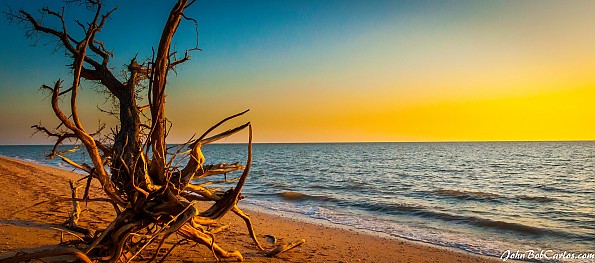
(photos courtesy of JohnBobCarlos)
Source: received for testing via the Trailspace Review Corps
(Sample provided by Sierra Designs for testing and review)
Great initial impression of this new design. Lightweight backpacking tent that is very easy to set up. Hybrid design means that the interior stays dry during rainy setup. Spacious interior with good ventilation.
Freestanding tent but the gear porches do need to be staked out for optimal ventilation and a taut pitch.
Pros
- Easy to set up
- Hybrid design keeps interior dry during rainy set up
- Good ventilation
- Lightweight
- Very spacious
- Awning design allows for a view, ventilation and clutter free entry
Cons
- Slight condensation in very calm and cool conditions
- No way to cover foot box vent partially to prevent splash back during down pour.
- Door zipper can catch at point where rain guard begins
I have been shopping for a tent to use on my AT thru-hike next year. This is a brand new design by Sierra Designs that I was leery to try since there were no reviews anywhere. I just received this tent and only have one night of use so this review is based on first impressions. I tried to simulate a variety of conditions in my first trial.
I weighed the tent immediately upon opening the box, the tent, poles, stakes, guy lines, instructions all as packaged in stuff sacks weighed in at 3.8 lbs. The tent packs down into a nice stuff sack with a separate pole and stake sack that can be attached or detached.
Setup is very intuitive, had it set up in my living room in 3 minutes then I saw the instructions in the bottom of the pole sack. All seams are taped but the instructions did recommend seam sealing at all points of sewn connections for best results. I broke down the tent and replaced items in stuff sacks. I discovered that the two built in "poles" in the tent do necessitate them being oriented in the proper direction so they don't break when you roll the tent back up. I would not put this tent in a compression sack because of that, though it packs away small enough I don't think I would want to anyway.
Second setup was on my back patio in 5 to 10 mph breezy conditions with occasional gusts. I was unable to stake corners because I was setting up on cement, but found this tent very easy to set up even in the wind due to the single pole hubbed design. This is an UL tent so I felt that using a footprint would be wise to protect the floor of the tent, I used a sheet of Tyvek.
I used weights to secure the guy lines on the gear closets to get a taut pitch. I placed my gear inside to weigh down the tent. It seemed very stable in the breeze. There are four additional guy out points to use in windy conditions for stability and guy lines are included. A generous spray down with the hose didn't reveal any leaks. Simulating a downpour did reveal minor splash back on the mesh of the foot box but contents of the tent remained dry.
The single door of the tent is huge and has a large mesh window that can be opened for added ventilation. You do have to be mindful of the awning when getting in and out of the tent. In wet conditions it is wise to tap the awning prior to getting out of the tent to get rid of any extra water. The zippers work well but the did seem to catch a bit at the point where the added rain guard on the zipper starts. The high ceiling and light tent color make this tent feel even more spacious than it already is.
This is the first UL 2-person tent I have been in that truly feels like it can accommodate two people comfortably. The wide entrance allows for two people to sit side by side at the doorway. The tent does slope down at the back single wall portion of the tent, but the ceiling height is high enough for 2 people to sit facing one another with one at the door and one towards the foot before the slope. I am 5'8" and I had my son who is 6'1" also check out the interior space of the tent. Each side of the tent has interior access to the gear closet and also an interior mesh pocket.
Over night the temperature dropped to 39 degrees and very calm conditions. I initially went to bed with the tent door window open all of the way but as it got chilly I closed it. There is always a small portion that remains open to vent on the door. The foot box vent has no option to close it even part way. There was plenty of room for two sleeping pads side by side without touching tent walls. Tent length was plenty for someone 5'8" to not touch either end of tent. I woke up several times during the night to check for condensation. It wasn't until about 3:30 am that I noticed a slight bit of condensation on the upper back part of the single wall portion of the tent. I opened the front window a little and when I woke in the morning the condensation had not increased.
Overall impression after sleeping overnight was that this is a very comfortable spacious tent that feels very sturdy. I like the gear closets with interior access for storage that allows a clutter free front door. I would try to leave the front window open as much as possible for better ventilation, especially in very calm conditions. The large vent at the foot had me keeping my wool socks on all night. You do have to basically crawl out of the tent due to the 15 inch awning, but I prefer that to crawling through a vestibule or a wet entry during rain.
My only gripe about the tent would be that I wish there was a panel on the foot box that would allow for at least partial closure during times of downpour to protect from splash back. Though I detected a small amount of condensation on the single wall portion of the tent, I will need further use in a variety of conditions utilizing the mesh window to really weigh in an informed opinion about it. I will update this review after more use, but so far I really like it and plan to use it on the AT.
UPDATE 3/27: After testing out this tent in very stormy conditions I am quite pleased. I set up the tent in a windy cold rain after a 12-hour shift. Even tired and cold, the setup was quick and easy even with wet cold hands and the interior stayed completely dry. I securely guyed out all lines since it was quite windy, tornado warnings had been issued nearby so it was pretty stormy. I was able to keep the front window open all of the way during most of the storm. I did have to close it up just about 1 inch during a driving downpour due to a little splash back hitting the window screen.
No water entered in the front of the tent. Splash back was an issue on the footbox vent. The screen was covered with water drops, but the interior remained dry. My shoes remained dry in the gear closet and I didn't experience any splash back on the mesh on either gear closet. The tent was solid even when the wind shifted and hit it broad side. Definitely need to secure guylines in windy weather for stability. Even after a downpour there was no puddling anywhere on the tent and the awning drained run-off well to keep entry and exit dry.
During the night the temperatures dropped to 40 degrees with intermittent storm cells passing through. I left the door window all of the way open for the rest of the night. In the morning I found the floor and front of the tent were completely dry. The upper rear single wall portion of the tent had a film of condensation but not enough to form drops. Even thought the mesh of the footbox was often covered with water drops none of the water reached the inside or got my sleeping bag wet.
Overall I am very happy with this tent. The completely dry and easy setup is worth the small amount of condensation in my opinion. I am still not sure about the splashback on the footbox screen, I really wish there was a flap you could close during heavy downpours.
Update 4/17/14
Camping at Lake Tahoe with temperatures ranging from 60's to a low of 33 degrees. Clear with a slight breeze lakeside. Front window panel left open and no condensation at all in the tent this morning. I remembered to snap a few photos at sunrise before we broke camp. The other tent in the background is the Big Agnes Copper Spur 2 UL for comparison. The more I use this tent the more I like it.
Please note the following changes: I am now using the Sierra Designs footprint made for this tent and it worked much better than the Tyvek sheet. I did change out the stock guy lines for a more reflective Night Ize line. The breeze was minimal so the extra lines were not staked out this time. I am also using MSR Ground Hog stakes instead of the stock stakes. The included stakes work fine I just personally prefer the longer MSR stakes with the "Y" design.
The footbox vent is protected by an awning but splash back can still occur in a driving rain.
Update 9/20/2014
After a summer of use I have upped my review to 5 stars. I found my initial concerns about splashback on the footbox vent have not been enough to hold back that last star. At no time did the interior get wet from splashback.
I am now used to leaving the front window flap open to maximize air flow and have not had any issue with condensation beyond a slight sheen on the single wall section. Quick and easy setup and tear down makes this tent my favorite during inclement weather.
Update 7/9/2015
I have few additional comments after extensive use on the Appalachian Trail. This tent rocks most of the time. It is wicked fast to set up, sturdy, durable, roomy and light. It will still be my tent of choice for California backpacking and I would continue to rate it 5 stars for use in this climate.
I can’t however recommend it for 3-season use on the AT and would reduce it to 3 stars and then only recommend it for summer use. I quickly found out during this trip that rainy weather on the East Coast is nothing like the rainy weather I experienced testing this tent in California.
First the good stuff: The tent is virtually in the same condition now as when I started. Fabric is intact (I did use a footprint 100% of the time), screens are intact, zippers are all functional but must be used with a certain amount of care, poles withstood high wind conditions that collapsed several other types of tents and tarps (I did stake out all points as recommended for wind conditions).
The not so good stuff: More often than not the interior of the tent was as wet as the exterior. Condensation was severe in the single wall portion of the tent even with door vent all the way open. Additionally, with no way to close the vents the swirling mist, fog and rain just came right on in. Site selection is the key to any sort of success in rainy weather, but when conditions are changeable and windy, even that doesn’t help much. Even setting up underneath cover didn’t solve the problem because the fog was as thick inside as outside. Others types of tents and tarps nearby were not experiencing this problem.
During intense driving rain splash back was a problem, often flooding the tent with water and mud. Making sure there was plenty of leaves around along the edges of the tent helped some but did not alleviate the problem. The tent fabric did remain water resistant, enough that I often woke up with a large puddle of muddy water contained in the tent.
Once again, I wish there was at least an option to completely close off vents. The two internal poles can be removed to allow the tent to pack better, but that makes set up a much more laborious endeavor in the rain. If those interior poles were just an inch shorter, this tent would pack much better and be able to fit in a smaller size backpack.
Source: bought it new
Price Paid: $287 (on sale)
Great tent for hiking buddies that don't want to sleep on top of one another. Lots of room that is all usable.
Pros
- Rain proof
- Pitches fast and dry
- Can actually fit two human adults
Cons
- Storage space
- Ease of entry/exit
I picked the UL version of this tent up right before the FL came out, so I snagged it at a heck of a deal.
This was my first backpacking specific tent and I got it because it was so different. The hybrid single double wall makes everything easy to pitch and keep dry and it goes up very quickly.
I have used it around Michigan for four months on beaches, rivers, and deep forests. It has stood up to everything Mother Nature can throw at it and wants more.
When I take it solo, it's a palace. Everything stays nearby, dry and protected. When doubling up you still have a little elbow room. Storage becomes the issue with two people. The gear closets are nice, but small. My pack barely fit under and the toes of my boots were exposed all night.
That being said, not having to crawl over your gear is a very nice feature. On that note, the door; large, easily vented but still protected. Because it is a single door at your head, crawling in and out becomes a challenge. I got nice and muddy first thing in the morning crawling out to make breakfast. When I sleep solo I actually sleep with my feet at the door so exit is easier in the morning.
Overall it's a great tent that is very well made.
Source: bought it new
Price Paid: $170-ish
Your Review
You May Like
Specs
| Price |
MSRP: $359.95 Historic Range: $199.99-$359.95 Reviewers Paid: $170.00-$287.00 |
| Capacity |
2 |
| Minimum Weight |
3 lb 7 oz / 1.56 kg |


